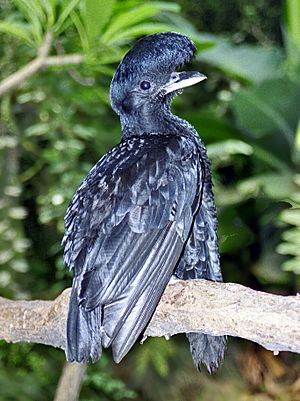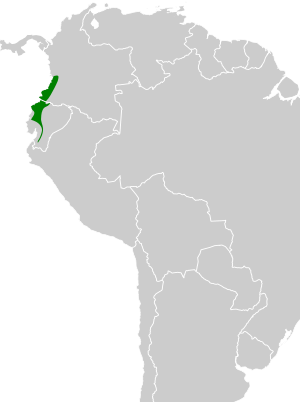Long-wattled umbrellabird facts for kids
Quick facts for kids Long-wattled umbrellabird |
|
|---|---|
 |
|
| Cephalopterus penduliger at Skansen, Stockholm | |
| Conservation status | |
| Scientific classification | |
| Genus: |
Cephalopterus
|
| Species: |
penduliger
|
 |
|
The long-wattled umbrellabird (Cephalopterus penduliger) is a unique bird known for its special umbrella-like crest and a long, hanging wattle. It belongs to the Cotingidae family, which includes many colorful birds. In Spanish, people call it by different names like pájaro bolsón (bag bird) or vaca del monte (mountain cow). This bird is quite rare and lives in wet, misty mountain forests, especially on the Pacific side of southwest Colombia and western Ecuador. Sometimes, you might find them in lower areas too.
Contents
Description of the Umbrellabird
The male long-wattled umbrellabird is about 40–42 cm (16-17 inches) tall, which is roughly the size of a small chicken. The female is a bit smaller, usually 35–37 cm (14-15 inches) tall.
The most noticeable feature of the male is a large, feather-covered flap of skin called a wattle on its throat. Females and young birds have no wattle or a much smaller one. The male can control the length of this wattle, even pulling it back when it flies. The male's feathers are generally black.
The bird's scientific name, penduliger, comes from a Latin word meaning "hanging." This name perfectly describes its unique hanging wattle.
Where the Umbrellabird Lives
This special bird is found only in a specific area, mainly from southwestern Colombia to the El Oro province in Ecuador. This region is known as the Tumbes-Chocó-Magdalena bioregion.
It prefers to live in humid mountain forests. You can find them at heights of 1,500 to 1,800 meters (about 4,900 to 5,900 feet) above sea level. They live on the ridges and sides of the Andes mountain range.
Umbrellabird Ecology
What Umbrellabirds Eat
The long-wattled umbrellabird mostly eats fruit. They especially like large fruits from palm trees (Arecaceae), avocado-like trees (Lauraceae), and plants like guava (Myrtaceae). They also eat small insects and other tiny animals.
Reproduction and Life Cycle
Long-wattled umbrellabirds have a unique way of finding partners called lek mating. This is where male birds gather in special open areas, called leks, to show off. Female birds visit these leks to choose a mate. Females often pick males that seem strong and good at defending their space.
Nests are built in trees or tall tree ferns, usually about 4.5–5.0 meters (15-16 feet) off the ground. These birds lay only one egg at a time. The egg takes about 27 or 28 days to hatch. Only the female bird sits on the egg and takes care of the baby bird. She brings food to her chick about once every hour. This food includes insects, small animals, and food she brings up from her stomach.
Conservation of the Umbrellabird
The long-wattled umbrellabird is considered a vulnerable species by the IUCN. This means it is at risk of becoming endangered. In 2012, experts estimated there were only about 6,000 to 15,000 adult birds left.
The biggest threats to these birds are the destruction of their forest homes through deforestation (cutting down trees) and hunting. Their lek mating areas are easy to find, which makes them especially vulnerable to being trapped.
Good news is that the long-wattled umbrellabird lives in several protected areas. Making these protected areas stronger and connecting them could greatly help the species. Also, taking care of the forest and planting new trees (reforestation) are important ways to help these unique birds survive.
See also
 In Spanish: Paragüero corbatudo para niños
In Spanish: Paragüero corbatudo para niños


